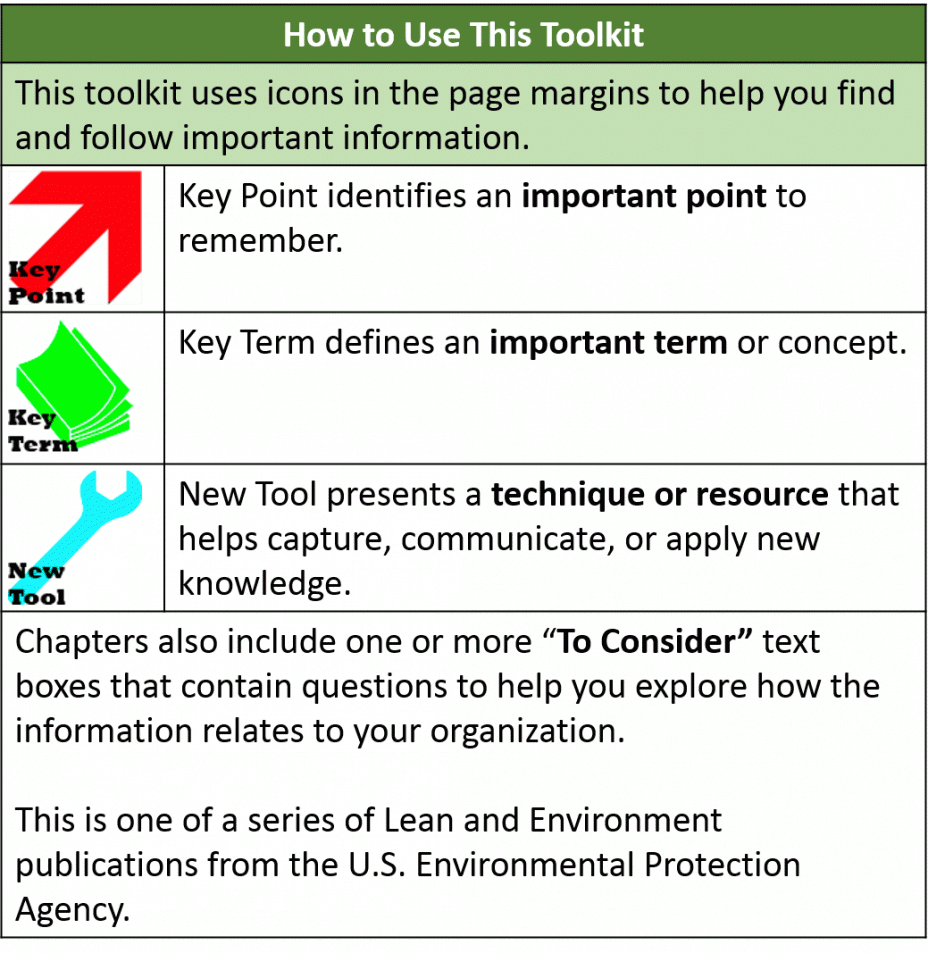The Lean & Energy Toolkit: Preface
- How to Use This Toolkit
- Purpose of This Toolkit
- Key Questions Addressed by This Toolkit
- Toolkit Navigation
How to Use This Toolkit

Purpose of This Toolkit
![]() This Lean, Energy & Climate Toolkit offers Lean implementers practical strategies and techniques for enhancing Lean results—waste elimination, quality enhancement, and delivery of value to customers—while improving energy efficiency and reducing energy use, greenhouse gas emissions, costs, and risk. The toolkit is also intended to introduce Lean practitioners to the extensive array of energy management resources available from EPA, the U.S. Department of Energy (DOE), and other organizations.
This Lean, Energy & Climate Toolkit offers Lean implementers practical strategies and techniques for enhancing Lean results—waste elimination, quality enhancement, and delivery of value to customers—while improving energy efficiency and reducing energy use, greenhouse gas emissions, costs, and risk. The toolkit is also intended to introduce Lean practitioners to the extensive array of energy management resources available from EPA, the U.S. Department of Energy (DOE), and other organizations.
![]() The “Lean” methods discussed in this toolkit are organizational improvement methods pioneered in the Toyota Production System. Leanproduction and Lean manufacturing refer to a customer-focused business model and collection of methods that focus on the elimination of waste (non-value added activity) while delivering quality products on time and at a low cost. The toolkit assumes that you are familiar with Lean methods. For those who want to learn more about Lean, see EPA’s Lean and Environment website (www.epa.gov/lean).
The “Lean” methods discussed in this toolkit are organizational improvement methods pioneered in the Toyota Production System. Leanproduction and Lean manufacturing refer to a customer-focused business model and collection of methods that focus on the elimination of waste (non-value added activity) while delivering quality products on time and at a low cost. The toolkit assumes that you are familiar with Lean methods. For those who want to learn more about Lean, see EPA’s Lean and Environment website (www.epa.gov/lean).
This toolkit provides strategies and information that can be used throughout your Lean and Energy journey. Chapters 1-3 help you understand the relationship of Lean to energy use, the benefits of systematically reducing energy use through Lean and ways to integrate energy efficiency and greenhouse gas management efforts into your organization’s business strategy and management practices. Chapters 4-6 describe how to identify and implement energy savings opportunities in the context of Lean. These strategies leverage Lean methods such as value stream mapping, kaizen events, total productive maintenance, and standard work to improve energy and operational performance, while also incorporating energy assessment and reduction tools that can enhance Lean implementation.
Key Questions Addressed by This Toolkit
Lean focuses on identifying and eliminating waste. Environmental improvement and energy reduction efforts that distract from classic Lean efforts may not get much traction. By contrast, this toolkit contains strategies and techniques that can enable Lean practitioners to easily identify energy wastes and improvement opportunities alongside traditional Lean wastes and improvement opportunities. To accomplish this, the toolkit aims to answer the following questions:
What is the relationship between Lean and energy use and climate change? Energy savings and greenhouse gas reductions are often obtained during traditional Lean events, but by explicitly focusing on energy use you can get substantially greater energy improvements. By eliminating manufacturing wastes, such as unnecessary processing and transportation, businesses reduce the energy needed to power equipment, lighting, heating, and cooling. Chapter 1 describes benefits of combining Lean, energy improvement, and greenhouse gas reduction efforts. Chapters 2 and 3 explore the relationship between Lean and energy use, and provide background information on energy use and costs.
How do you know how much energy is used in a facility and where it is being used? A key step in effective Lean and energy efforts is learning where to target energy-reduction activities. Chapter 4 discusses techniques for assessing energy use and greenhouse gas emissions reductions, identifying opportunities to save energy in the context of Lean. Methods include energy treasure hunts, greenhouse gas inventories, value stream mapping, and Six Sigma.
How can you reduce energy use and greenhouse gas emissions with Lean methods? Chapter 5 examines specific opportunities for using Lean to improve energy efficiency and reduce greenhouse gas emissions, including methods such as kaizen events, total productive maintenance, right-sized equipment, plant layout, standard work, transportation efficiency and visual controls.
Toolkit Navigation
- Contents & Acknowledgements
- Executive Summary
- Preface
- Chapter 1: Introduction
- Chapter 2: Integrating Lean, Energy Efficiency and Greenhouse Gas Management
- Chapter 3: Overview of Energy Use and Lean
- Chapter 4: Energy and Greenhouse Gas Assessment Strategies
- Chapter 5: Energy and Greenhouse Gas Emission Reduction Tools and Strategies
- Chapter 6: Conclusion
- Appendix A: Energy and Greenhouse Gas Management Service Providers, Resources and Tools
- Appendix B: Sector-Focused Energy Reduction and Greenhouse Gas Management Resources
- Appendix C: Energy Conversion Resources and Rules of Thumb for Estimating Energy Cost Savings
